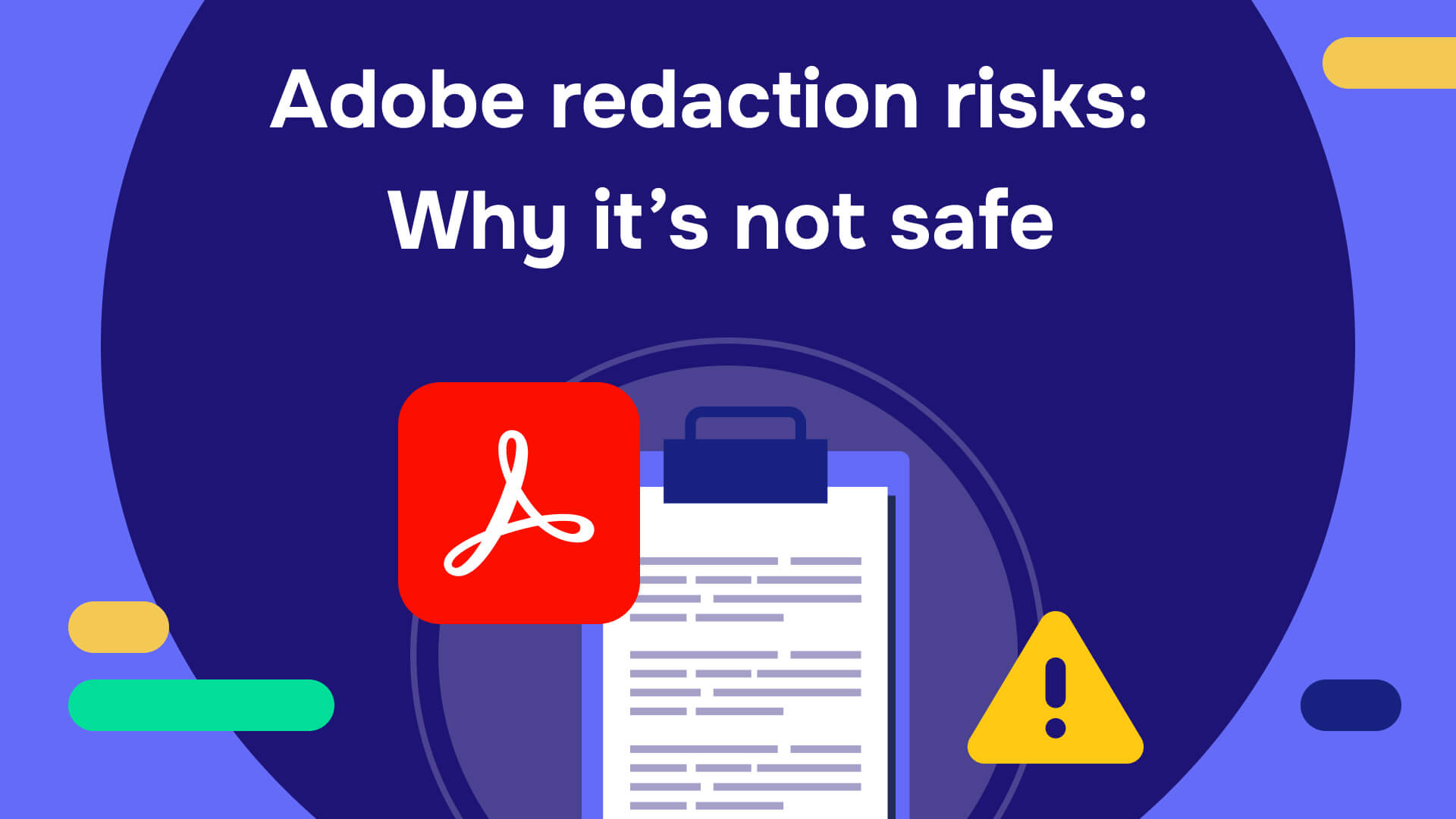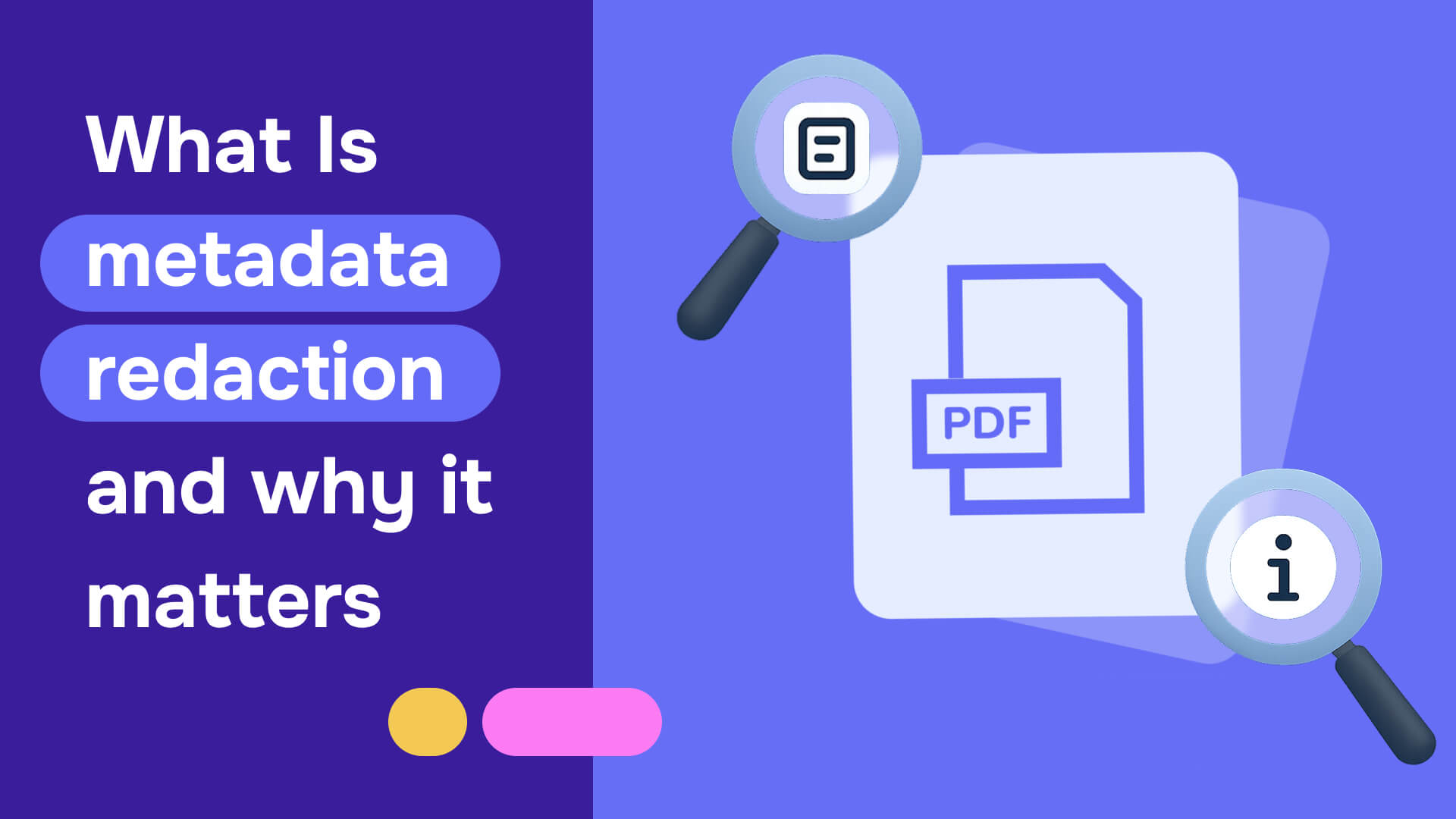With approximately 196 million new individuals joining the online world each year, the digital landscape expands exponentially, bringing forth opportunities and risks. As you traverse this vast virtual realm, protecting your privacy becomes paramount.
That's where redaction comes to your rescue, ensuring your sensitive information remains secure and confidential. And at the heart of this process lies the redaction report, acting as your guide to achieving risk-free and effective redaction.
A redaction report is a document that outlines the process of censoring sensitive information to prevent unauthorized disclosure. It serves as a record of actions taken to protect your privacy and comply with laws.
Redaction logs provide transparency by detailing the methods used to remove confidential details. They play a vital role in compliance, documenting adherence to data protection regulations and court-ordered redaction mandates.
In this blog, we'll talk about the purpose, use cases, and reliability provided by these reports.
What are redaction reports?

A Redaction report records the actions to safeguard sensitive information by removing or censoring the specifics. The primary purpose of these reports is to provide a transparent account of the steps taken to protect privacy and maintain compliance.
It is tangible evidence of the efforts to safeguard personal information from unauthorized access or disclosure. Furthermore, they outline the actions taken, making it easier to understand and trust the privacy measures implemented.
Through a report, the redaction process becomes documented and traceable. This record highlights the methods and techniques used to identify and remove confidential information, ensuring that only authorized individuals can access specific details.
Redaction reports are crucial in maintaining compliance with various legal requirements, such as data protection regulations or court-ordered redaction mandates.
They demonstrate a commitment to privacy and serve as an assurance that the necessary steps have been taken to safeguard sensitive information.
Purpose of a redaction log
They serve two primary purposes.
First, they allow disseminating of non-sensitive information to a broader audience while keeping confidential details hidden.
Second, they record the redacted information, offering transparency and accountability.
Here are the other purposes of these reports:
- To summarize information while protecting sensitive or confidential details.
- To conceal or remove specific information, such as personal data or classified material, to maintain privacy and security.
- To prevent unauthorized access or disclosure of sensitive information.
- To provide transparency and accountability by documenting what information has been redacted.
- To balance the need for transparency and public access to information with safeguarding sensitive data.
- To ensure that only authorized individuals can access the complete details while still providing a summary or overview of the document's contents for others.
Steps to create a redaction report
Creating redaction logs involves several steps to handle sensitive information appropriately. Here's a simplified guide on how a redaction report is typically created:
1.Determine the specific information that needs to be redacted, such as personal identifiers, financial data, or classified details. Then, understand the legal and privacy requirements related to the information that must be protected.
2.Thoroughly examine the document or file to identify all sensitive information instances requiring redaction. This can include text, images, tables, or confidential data content.
3.Choose the appropriate redaction method based on the document type and content. This can involve using specialized redaction software, physical redaction tools (e.g., black markers), or electronic editing features to conceal or remove sensitive information.
4.Using the selected method, apply redactions to the identified sensitive information. Ensure all data instances are properly concealed or removed to avoid inadvertent disclosure.
5.Maintain a record or log of the redaction process. This documentation should include details such as the date of redaction, the specific information redacted, and the method used for redaction.
6.Double-check the redacted document to ensure all sensitive information is concealed correctly or removed. Then, carefully review each page to verify the accuracy and effectiveness of the redaction process.
7.Compile a summary report that outlines the purpose of redaction, the document's contents, and the specific information that has been redacted. Include any relevant legal or regulatory references and the details of the redaction process.
8.Have a designated individual or team review the redaction report to ensure its accuracy, completeness, and compliance with organizational policies and applicable laws.
Following organizational guidelines and consulting with legal experts is essential to ensure compliance with relevant laws and regulations while creating reports.
Please note that the specific steps may vary depending on the organization, industry, and the nature of the document being redacted.
Use cases of redaction logs

Here are some common areas where redaction logs are utilized:
Legal sector
They play a crucial role in the legal field, ensuring the secure handling of sensitive information during court proceedings, case filings, or document disclosures. In addition, they effectively protect personal identifiers, financial data, or classified evidence.
Government agencies
Government agencies rely on redaction logs to safeguard classified or confidential information in investigative reports, intelligence briefings, or Freedom of Information Act (FOIA) releases. This ensures the utmost security and confidentiality of sensitive data.
Healthcare
These reports protect patient privacy in the healthcare sector by removing personal health information (PHI) from medical records, research papers, or health insurance claims. This compliance with privacy regulations ensures the highest level of confidentiality.
Journalism and media
Journalists and media organizations confidently utilize redaction notes when publishing sensitive or classified documents.
This ensures the protection of source identities and prevents the disclosure of sensitive details that could compromise national security or ongoing investigations.
Financial institutions
These reports are also confidently used in the financial industry to secure confidential information, such as bank statements, transaction records, or investment portfolios. This guarantees that only authorized individuals have access to complete financial data.
Are these reports 100% reliable?
While redaction logs are essential in safeguarding privacy and ensuring compliance, they are not guaranteed 100% reliable. In addition, redaction processes involve human judgment and technology, which can have limitations and potential risks.
Understanding and addressing these factors is essential to minimize the chances of errors or breaches. Here are a few considerations:
1. Human errors
Redaction processes often rely on human reviewers to identify and redact sensitive information. Human error, such as overlooking or improperly editing specific details, can occur despite best efforts.
2. Technology limitations
The effectiveness of redaction tools and software can vary. While they are designed to identify and remove sensitive information accurately, false positives or negatives are still possible. g Privacy and Ensu
3. Complex document formats
Redacting information from complex formats, such as scanned images or documents with embedded content, can be challenging. It may require additional steps and specialized techniques to ensure complete and accurate redaction.
4. Metadata leakage
Redaction of visible content does not guarantee the removal of underlying metadata. Metadata, such as document properties or hidden information, could still contain sensitive details that may unintentionally be shared when the document is exchanged or published.
5. Data recovery
In some cases, recovering redacted information through advanced techniques or tools may be possible. However, this poses a risk if the redacted data falls into the wrong hands and is subjected to unauthorized attempts at recovery.
How to enhance their reliability?
To enhance the reliability of a redaction report, you can take the following steps:
1.Define clear and comprehensive redaction policies that outline the criteria for identifying sensitive information, the redaction process, and quality control measures. Ensure these policies align with applicable laws, regulations, and industry best practices.
2.Provide thorough training to individuals involved in the redaction process, including reviewers and administrators. Train them on the redaction policies, techniques, and proper use of redaction tools to minimize human error and enhance accuracy.
3.Introduce rigorous quality assurance checks throughout the redaction process. Involve multiple reviewers to validate the effectiveness of redaction and address any inconsistencies or errors.
4.Invest in reputable, reliable redaction tools like Redactable that offer advanced features and accurate detection capabilities. Stay updated with the latest versions of the tools and verify their effectiveness through testing and evaluation before implementation.
5.Create a detailed audit trail or activity log documenting the entire redaction process. Capture the date, specific redacted content, responsible individuals, and any validation or quality control steps taken.
6.Stay proactive in reviewing and updating your redaction processes to adapt to changing privacy requirements and emerging risks. Stay informed about evolving laws and regulations related to privacy protection and adjust your redaction practices accordingly.
7.Conduct periodic assessments of your redaction processes and reports to identify areas for improvement. Seek feedback from stakeholders, including internal personnel and external auditors, to enhance the reliability and effectiveness of your reports.
By following these steps, you can enhance the reliability of your reports, ensuring that they provide accurate and trustworthy documentation of the redaction process and contribute to robust privacy protection and compliance efforts.
To ensure effective redaction, you can use Redactable, the instant and permanent solution designed to provide robust features for safeguarding your sensitive information.
With Redactable, you gain access to a powerful toolset that simplifies redaction, ensuring the privacy and confidentiality of your documents.
Whether you're dealing with legal contracts, medical records, or any other sensitive data, Redactable offers a seamless and efficient solution. Let's explore how Redactable's advanced capabilities can elevate your redaction process and provide peace of mind.
Redactable: The reliable solution

Redactable is the go-to platform for robust redaction solutions. Our expertise and resources provide the means to remove sensitive information from your documents securely.
By utilizing our services, you can confidently safeguard the confidentiality of your data and comply with privacy regulations. Redactable prioritizes user-friendly experiences, ensuring seamless navigation of their platform and delivering accurate redacted results.
You have the power to maintain privacy, comply with regulations with us, and securely share information while controlling what is visible to different audiences.
How can Redactable help create better redaction logs?

By leveraging Redactable's advanced algorithms and AI capabilities, you can quickly detect and redact confidential data, reducing the likelihood of errors or oversights.
This automation ensures consistency and standardization throughout the redaction process, as predefined rules and patterns are applied uniformly across multiple documents.
The result is a more reliable and professional report where sensitive information is reliably concealed, maintaining privacy and compliance with regulations.
1. Easy setup and scalability
Redactable provides a seamless setup process, allowing you to work efficiently on large redaction projects. Its convenience and scalability ensure that you can handle extensive redaction tasks without encountering any hindrances, improving the reliability of your reports.
2. Permanent redaction and data security
Redactable removes metadata and hidden document elements, ensuring that redactions are permanent and cannot be hacked or reverse-engineered. This enhances the safety and reliability of your reports, as the concealed information remains protected.
3. Fast Redaction
Fast redaction is a standout feature of Redactable that allows users to redact documents efficiently in a significantly reduced time.
With an average user spending only 2.5 minutes to redact a 10-page document, you can optimize productivity and streamline the redaction process.
4. Advanced AI features
Redactable's built-in AI features, such as auto-detection of confidential data and the ability to search for specific terms for redaction, enhance the accuracy and reliability of your reports.
The advanced capabilities of the platform help ensure that sensitive information is thoroughly and consistently redacted.
5. Easy document management
Redactable allows you to import your existing documents from other services, such as Box or Dropbox, facilitating efficient document management. This streamlines the process of accessing and organizing documents, contributing to the reliability of your reports.
6. Redaction Certificates for tracking
Redactable automatically generates Redaction Certificates, providing a clear record of who performed the redaction and when. This tracking feature enhances accountability and transparency, further increasing the reliability of your reports.
Conclusion
A redaction report is vital for safeguarding privacy and compliance in various industries. By effectively concealing sensitive information, these reports ensure that confidential data remains protected and inaccessible to unauthorized individuals.
With the ever-increasing importance of data privacy and regulatory requirements, utilizing a reliable redaction tool like Redactable can significantly enhance the efficiency and accuracy of the redaction process.
With its advanced features, ease of use, and comprehensive support, Redactable is the ideal solution to streamline your redaction efforts and create reliable, professional reports. Protecting your privacy is essential, and Redactable makes it easier. Try it for free to learn more.







